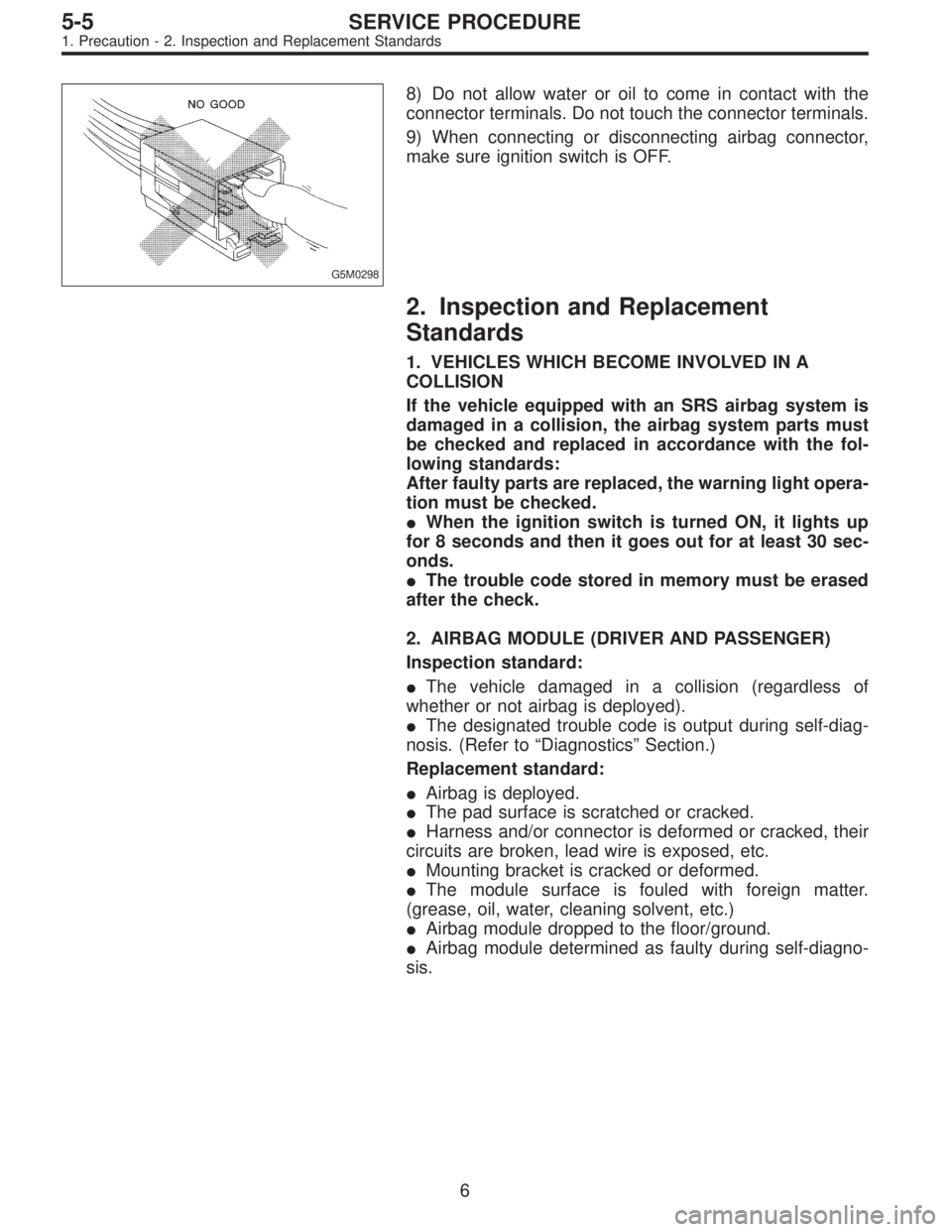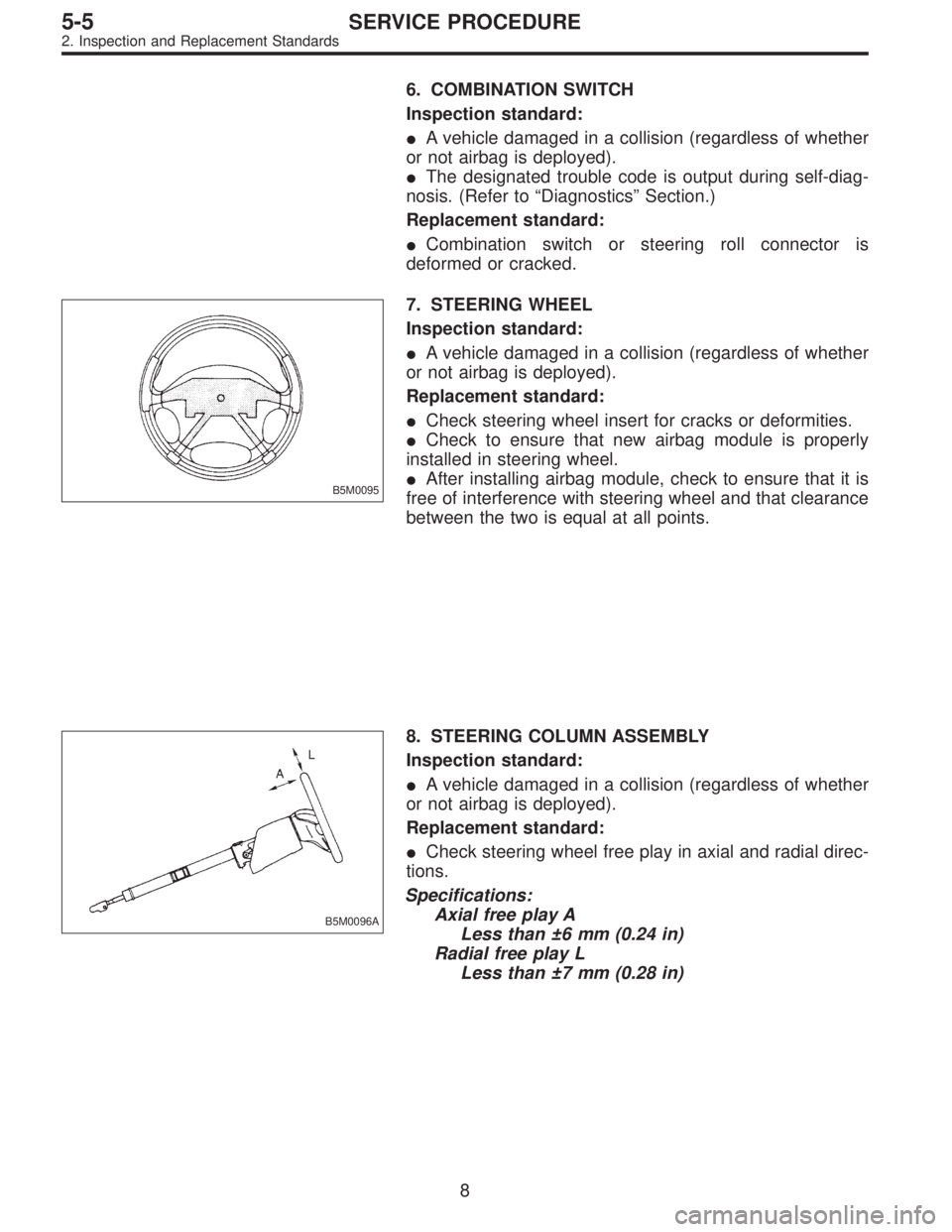Page 1650 of 3342
B5M0030A
12) Disconnect harness connectors.
�115P/Gray
�
222P/Brown
�
322P/White
�
420P/Blue
�
522P/Black
�
64P/Sky blue
�
71P/Black
�
81P/Black
CAUTION:
Be sure to hold socket section and not harness when
disconnecting.
NOTE:
Put matching mark, if necessary, for easy re-assembly.
13) Remove the installing bolt.
G5M0282
14) Remove front defroster grille and two bolts.
15) Remove instrument panel carefully from the body.
CAUTION:
Take care not to scratch the instrument panel and
related parts.
7
5-4SERVICE PROCEDURE
1. Instrument Panel
Page 1651 of 3342
G5M0602
CAUTION:
When storing removed instrument panel with passen-
ger airbag module, place it standing up on the floor.
B5M0031A
B: INSTALLATION
1) Installation is in the reverse order of removal.
Do the following:
When setting instrument panel into position, push two pins
into grommet on body panel.
CAUTION:
�Be careful not to snag the harness.
�Make sure to connect harness connectors.
�Take care not to scratch the instrument panel and
related parts.
B5M0032
2) Set clips located at both inside ends of instrument panel
onto body side.
8
5-4SERVICE PROCEDURE
1. Instrument Panel
Page 1654 of 3342
G5M0291
1. Precaution
1) If any of the airbag system parts such as sensors, air-
bag module, airbag control module and harness are dam-
aged or deformed, replace with new genuine parts.
G5M0292
2) When servicing, be sure to turn the ignition switch off,
disconnect the negative (�) battery terminal then the posi-
tive (+) terminal in advance, and wait for more than 20
seconds before starting work.
G5M0293
3) When checking the system, be sure to use a digital cir-
cuit tester. Use of an analog circuit tester may cause the
airbag to activate erroneously. Do not directly apply the
tester probe to any connector terminal of the airbag. When
checking, use a test harness.
G5M0294
4
5-5SERVICE PROCEDURE
1. Precaution
Page 1655 of 3342
G5M0295
4) Do not drop the airbag modulator parts, subject it to
high temperatures over 90°C (194°F), or apply oil, grease,
or water to it; otherwise, the internal parts may be damaged
and its reliability greatly lowered.
G5M0296
5) If any damage or open is found on the SRS airbag sys-
tem wire harness, do not attempt to repair using soldering,
etc. Be sure to replace the faulty harness with a new genu-
ine part.
G5M0297
6) Install the wire harness securely with the specified clips
so as to avoid interference or jamming with other parts.
7) Before connecting the airbag system to ground, make
sure that the grounding terminal is free from paint and
contamination.
5
5-5SERVICE PROCEDURE
1. Precaution
Page 1656 of 3342

G5M0298
8) Do not allow water or oil to come in contact with the
connector terminals. Do not touch the connector terminals.
9) When connecting or disconnecting airbag connector,
make sure ignition switch is OFF.
2. Inspection and Replacement
Standards
1. VEHICLES WHICH BECOME INVOLVED IN A
COLLISION
If the vehicle equipped with an SRS airbag system is
damaged in a collision, the airbag system parts must
be checked and replaced in accordance with the fol-
lowing standards:
After faulty parts are replaced, the warning light opera-
tion must be checked.
�When the ignition switch is turned ON, it lights up
for 8 seconds and then it goes out for at least 30 sec-
onds.
�The trouble code stored in memory must be erased
after the check.
2. AIRBAG MODULE (DRIVER AND PASSENGER)
Inspection standard:
�The vehicle damaged in a collision (regardless of
whether or not airbag is deployed).
�The designated trouble code is output during self-diag-
nosis. (Refer to“Diagnostics”Section.)
Replacement standard:
�Airbag is deployed.
�The pad surface is scratched or cracked.
�Harness and/or connector is deformed or cracked, their
circuits are broken, lead wire is exposed, etc.
�Mounting bracket is cracked or deformed.
�The module surface is fouled with foreign matter.
(grease, oil, water, cleaning solvent, etc.)
�Airbag module dropped to the floor/ground.
�Airbag module determined as faulty during self-diagno-
sis.
6
5-5SERVICE PROCEDURE
1. Precaution - 2. Inspection and Replacement Standards
Page 1657 of 3342

G5M0298
8) Do not allow water or oil to come in contact with the
connector terminals. Do not touch the connector terminals.
9) When connecting or disconnecting airbag connector,
make sure ignition switch is OFF.
2. Inspection and Replacement
Standards
1. VEHICLES WHICH BECOME INVOLVED IN A
COLLISION
If the vehicle equipped with an SRS airbag system is
damaged in a collision, the airbag system parts must
be checked and replaced in accordance with the fol-
lowing standards:
After faulty parts are replaced, the warning light opera-
tion must be checked.
�When the ignition switch is turned ON, it lights up
for 8 seconds and then it goes out for at least 30 sec-
onds.
�The trouble code stored in memory must be erased
after the check.
2. AIRBAG MODULE (DRIVER AND PASSENGER)
Inspection standard:
�The vehicle damaged in a collision (regardless of
whether or not airbag is deployed).
�The designated trouble code is output during self-diag-
nosis. (Refer to“Diagnostics”Section.)
Replacement standard:
�Airbag is deployed.
�The pad surface is scratched or cracked.
�Harness and/or connector is deformed or cracked, their
circuits are broken, lead wire is exposed, etc.
�Mounting bracket is cracked or deformed.
�The module surface is fouled with foreign matter.
(grease, oil, water, cleaning solvent, etc.)
�Airbag module dropped to the floor/ground.
�Airbag module determined as faulty during self-diagno-
sis.
6
5-5SERVICE PROCEDURE
1. Precaution - 2. Inspection and Replacement Standards
Page 1658 of 3342

G5M0311
3. FRONT SENSOR
Inspection standard:
�Check the front section (Refer to shaded area of vehicle
in figure) for damage, regardless of whether or not airbag
is deployed.
�Check whether or not the designated trouble code is
output during self-diagnosis. (Refer to“Diagnostics”Sec-
tion.)
Replacement standard:
�Bracket is deformed.
�Housing is cracked or deformed.
�The label (that identifies the manufacturing number) is
peeled or deteriorated.
�Harness circuit is broken, lead wire is exposed, corru-
gated tube is cracked, etc.
�Front sensor determined as faulty as a result of Diag-
nostics.
�Airbag is deployed.
�Front sensor dropped to the floor/ground.
4. MAIN HARNESS
Inspection standard:
�A vehicle damaged in a collision (regardless of whether
or not airbag is deployed).
�The designated trouble code is output during self-diag-
nosis. (Refer to“Diagnostics”Section.)
Replacement standard:
�Harness circuit is broken, lead wire is exposed, corru-
gated tube is cracked, etc.
�Connector is scratched or cracked.
�The designated trouble code is output during self-diag-
nosis.
5. AIRBAG CONTROL MODULE
Inspection standard:
�A vehicle damaged in a collision (regardless of whether
or not airbag is deployed).
�The designated trouble code is output during self-diag-
nosis. (Refer to“Diagnostics”Section.)
Replacement standard:
�Control module is cracked or deformed.
�Mounting bracket is cracked or deformed.
�Connector is scratched or cracked.
�Control module dropped to the floor/ground.
�Control module determined as faulty during diagnostics.
�Airbag is deployed.
7
5-5SERVICE PROCEDURE
2. Inspection and Replacement Standards
Page 1659 of 3342

6. COMBINATION SWITCH
Inspection standard:
�A vehicle damaged in a collision (regardless of whether
or not airbag is deployed).
�The designated trouble code is output during self-diag-
nosis. (Refer to“Diagnostics”Section.)
Replacement standard:
�Combination switch or steering roll connector is
deformed or cracked.
B5M0095
7. STEERING WHEEL
Inspection standard:
�A vehicle damaged in a collision (regardless of whether
or not airbag is deployed).
Replacement standard:
�Check steering wheel insert for cracks or deformities.
�Check to ensure that new airbag module is properly
installed in steering wheel.
�After installing airbag module, check to ensure that it is
free of interference with steering wheel and that clearance
between the two is equal at all points.
B5M0096A
8. STEERING COLUMN ASSEMBLY
Inspection standard:
�A vehicle damaged in a collision (regardless of whether
or not airbag is deployed).
Replacement standard:
�Check steering wheel free play in axial and radial direc-
tions.
Specifications:
Axial free play A
Less than ±6 mm (0.24 in)
Radial free play L
Less than ±7 mm (0.28 in)
8
5-5SERVICE PROCEDURE
2. Inspection and Replacement Standards